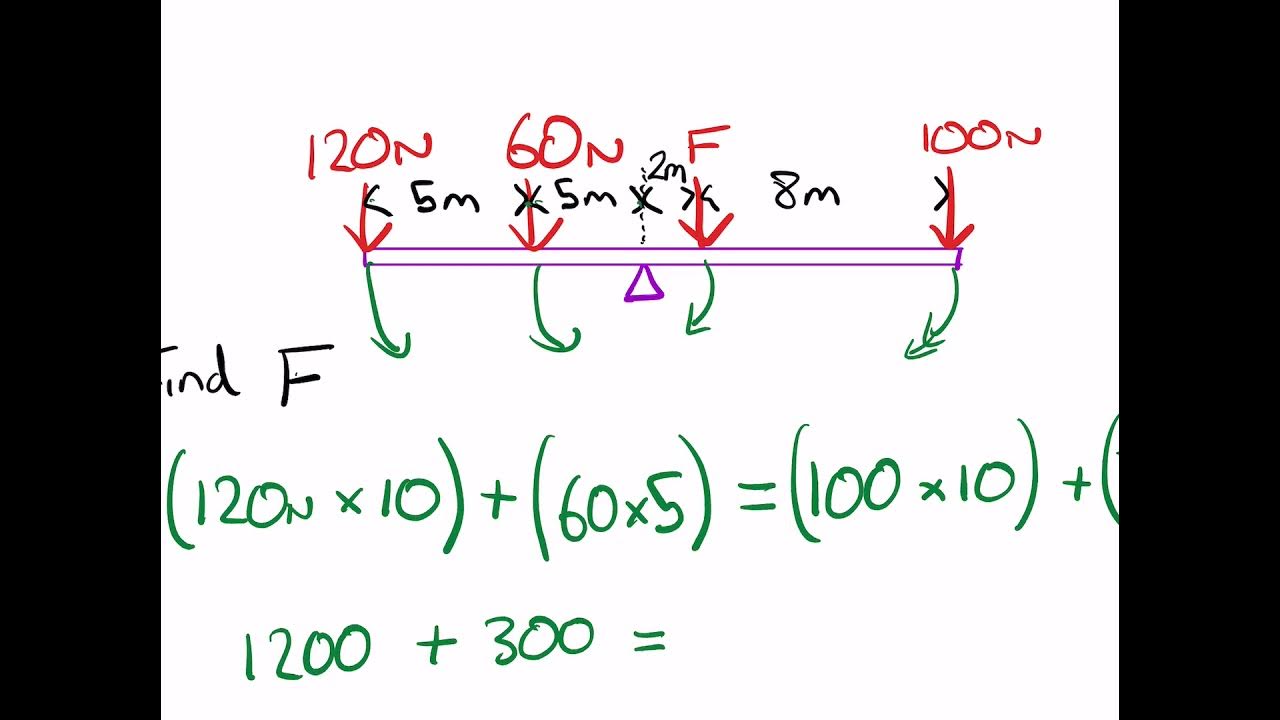Moments (part 2) | Moments, torque, and angular momentum | Physics | Khan Academy
TLDRIn this educational video, the instructor tackles moment and force problems using a seesaw model to clarify concepts like clockwise and counterclockwise moments. The script demonstrates calculations for balancing forces and moments, including determining the required force to maintain equilibrium on a lever and the weight distribution on a table's legs. Practical applications for engineers and architects are highlighted, emphasizing the importance of understanding moments in structural design.
Takeaways
- 🔄 The presenter aims to clarify moment and force problems, particularly the confusion between clockwise and counterclockwise terminology.
- 📐 A seesaw model is used to demonstrate the principles of moments, with the fulcrum representing the axis of rotation or pivot point.
- ⚖️ Forces and their respective distances from the fulcrum (moment arms) are crucial in calculating moments, which are then used to determine equilibrium.
- 🔵 The presenter uses colors to differentiate between clockwise and counterclockwise forces to avoid confusion.
- 🔢 Moments are calculated by multiplying the force by its moment arm distance, and the sum of clockwise moments must equal the sum of counterclockwise moments for equilibrium.
- 📚 An example is given with specific forces (10N, 50N, 5N, 20N) and their distances from the fulcrum to illustrate moment calculation.
- 🔄 The concept of a 'mystery force' is introduced, which is solved using the principle that the sum of moments must balance for no rotation to occur.
- 📉 The presenter corrects a calculation error during the explanation, emphasizing the importance of accurate math in physics problems.
- 🏠 A real-world scenario involving a table and its legs is used to demonstrate how moment principles apply to structural support and weight distribution.
- 📐 The table's center of mass and the distance of the weight from the supporting leg are key factors in determining the force each leg must withstand.
- 🔢 The force exerted by a table leg is calculated by balancing the moments caused by the weight of the table top and any additional weight, such as a box of textbooks.
- 🏗️ The importance of understanding moments is highlighted for professionals in fields like bridge construction, furniture manufacturing, and civil engineering.
Q & A
What is the main topic discussed in the video script?
-The main topic discussed in the video script is the concept of moments and force problems, specifically how to calculate and balance moments in a lever system, such as a seesaw or a table with unevenly distributed weight.
Why does the speaker mention potentially confusing clockwise with counterclockwise in the previous video?
-The speaker mentions the potential confusion to highlight the importance of consistent terminology when discussing moments and force problems, ensuring clarity in the explanation of the concepts.
What is the significance of the fulcrum in the lever system described in the script?
-The fulcrum, or pivot point, is the axis of rotation in a lever system. It is significant because it determines the balance point around which the lever will rotate, and it is essential for calculating moments of force.
How does the speaker plan to represent different types of forces in the script?
-The speaker plans to use colors to differentiate between clockwise and counterclockwise forces to avoid confusion and to clearly illustrate the direction and effect of each force on the lever system.
What is the purpose of calculating moments of force in the context of the seesaw example?
-The purpose of calculating moments of force in the seesaw example is to determine the balance point and to understand how different forces and their respective distances from the fulcrum affect the seesaw's rotation or equilibrium.
What is the formula used to calculate the moment of force?
-The formula used to calculate the moment of force is the product of the force (in Newtons) and its moment arm distance (in meters) from the fulcrum or pivot point.
How does the speaker determine the unknown force in the counterclockwise direction in the seesaw example?
-The speaker sets up an equation where the sum of all clockwise moments equals the sum of all counterclockwise moments, including the unknown force. By solving the equation, the speaker finds the magnitude and direction of the unknown force.
What is the practical application of understanding moments of force in the context of a table with a weight on top?
-Understanding moments of force is crucial for determining how much weight each leg of a table must support to maintain balance, especially when the weight distribution is uneven, as in the case of a heavy object placed off-center.
Why is it important to consider the moment of force for the table's legs in the script's example?
-It is important to consider the moment of force for the table's legs to ensure structural stability and to prevent the table from tilting or collapsing due to uneven weight distribution.
How does the speaker calculate the force exerted by each leg of the table in the script?
-The speaker calculates the force exerted by each leg of the table by setting up a moment balance equation, where the sum of all clockwise moments (due to the weight of the table top and any additional weight) equals the counterclockwise moment exerted by the leg, and then solving for the unknown force.
What is the role of the moment arm distance in the calculation of moments of force?
-The moment arm distance is the perpendicular distance from the fulcrum or pivot point to the line of action of the force. It is crucial in the calculation of moments of force because it determines the effectiveness of the force in creating a moment or torque around the fulcrum.
How does the speaker handle interruptions like a sneeze or a phone ringing during the explanation?
-The speaker acknowledges the interruption, briefly apologizes, and then continues with the explanation, ensuring that the flow of information is maintained despite the brief disruption.
Outlines
🔧 Moment of Force Clarification and Calculation
In this paragraph, the speaker aims to clarify the concept of moments of force and corrects previous terminology confusion between clockwise and counterclockwise. The speaker illustrates the concept using a seesaw as a lever system, applying various forces at different distances from the fulcrum. The forces include a 10-Newton force at a distance of 10, a 50-Newton force at a distance of 8, and a 5-Newton force at a distance of 4, among others. The goal is to find an unknown force that will balance the system by making the clockwise moments equal to the counterclockwise moments. The speaker uses color coding to differentiate directions and concludes by calculating the required force to maintain equilibrium, which turns out to be 15 Newtons in the clockwise direction, despite initially assuming it to be counterclockwise.
🏠 Table Stability and Weight Distribution
The speaker introduces a practical problem of weight distribution on a table to further explain moments of force. They describe a wooden table with a center of mass and a weight of 20 Newtons acting downwards. A box weighing 100 Newtons is placed on the table, and the speaker wants to determine how much weight is supported by each leg. By choosing an arbitrary axis of rotation, the speaker sets up a moment problem where the forces exerted by the table's legs must balance the moments created by the weight of the table and the box. The distances from the center of mass and the box to the axis of rotation are given as 2 meters and 1 meter, respectively. The speaker calculates the force exerted by one leg of the table, which is found to be 35 Newtons upwards, and deduces the remaining weight supported by the opposite leg, which is 85 Newtons.
📚 Importance of Moment Calculations in Structural Design
In the final paragraph, the speaker discusses the significance of moment calculations in the fields of bridge building, furniture manufacturing, and civil engineering. They emphasize the importance of understanding how the design of a structure affects the weight distribution among its supporting elements. The speaker uses the example of the table to illustrate how the position of a heavy object, such as the 100-Newton box, influences which leg bears more weight. The speaker concludes by highlighting the relevance of these calculations for engineers and architects to ensure structural integrity and balance.
Mindmap
Keywords
💡Moment of Force
💡Clockwise vs. Counterclockwise
💡Fulcrum
💡See-saw
💡Newton
💡Moment Arm
💡Equilibrium
💡Center of Mass
💡Torque
💡Axis of Rotation
💡Support Force
Highlights
Clarification of moment and force problems with an emphasis on consistent terminology.
Introduction of a seesaw model to illustrate the principles of moments and forces.
Application of forces with varying magnitudes and distances to demonstrate moment arms.
Differentiation between clockwise and counterclockwise forces using colors for clarity.
Calculation of moments for forces acting in a clockwise direction.
Equation setup for balancing clockwise and counterclockwise moments to prevent rotation.
Solving for an unknown force magnitude using moment equilibrium.
Practical example of a table with uneven weight distribution to illustrate moment of force in real-world scenarios.
Explanation of how to determine the force exerted by each leg of a table using moments.
Use of a moment arm to calculate the force exerted by a table leg in response to an off-center weight.
Mathematical approach to finding the force exerted by a table leg based on the moment of the weight.
Understanding the distribution of weight among table legs based on their distance from the center of mass.
Implications of moment of force calculations for bridge builders, furniture manufacturers, and civil engineers.
Importance of moment of force in architectural and engineering design for structural balance.
The impact of weight distribution on the moment of force and structural support requirements.
Conclusion summarizing the importance of understanding moments for practical applications in various fields.
Transcripts
Browse More Related Video
5.0 / 5 (0 votes)
Thanks for rating:





